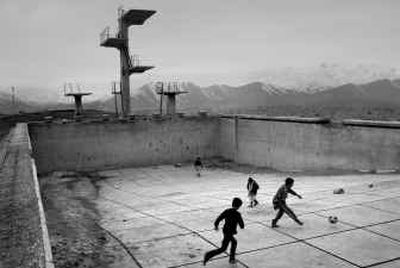Kabul remains city of struggle

KABUL, Afghanistan – After a generation of conflict, Afghans are slowly emerging from darkness. In the afterglow of last fall’s presidential election there is hope in Kabul.
Violence in the capital is now rare. Record numbers of children, including girls, are returning to rebuilt schools. U.S. trainers are forging a multiethnic Afghan army. Aid money is flowing in, and relief groups are helping put the health service and other institutions back on their feet.
Still, three years after America invaded Afghanistan following the Sept. 11 terror attacks, and the quick fall of the Taliban regime, Kabul remains a city of struggle. It’s a place where life is hard, and where many promises have yet to be met.
Afghanistan is the sixth least-developed country on Earth, recent U.N. figures say, and many of its people still live among the wreckage of war.
Herders tend flocks of sheep around destroyed tanks and downed aircraft. Children play soccer on the mortar-blasted bottom of an empty Soviet occupation-era swimming pool. Military veterans with amputated limbs beg on the roadside. Gravestones speckle the dusty landscape.
Millions of refugees have returned after long years of exile in Pakistan or Iran. Some are confident enough of the country’s stability to sink their savings into roomy new villas, fueling a breakneck construction boom.
But poorer returnees live as if they were still displaced. Across Kabul, they huddle in the cold hallways of abandoned, bullet-pocked government buildings.
Afghanistan’s economy is booming thanks to foreign aid and income from illegal drug production. Yet there are not enough jobs in Kabul, whose population has tripled to somewhere between 3 million and 4 million since the hard-line Taliban religious army was driven out. Estimates of unemployment in the city run as high as 50 percent.
Each morning before dawn, thousands of men offer themselves up at day laborer markets, carrying their paintbrushes, wheelbarrows and trowels and hoping to be among the lucky ones chosen to earn $6 – and a breakfast of bread and green tea – for a day’s work.
Some of that work is rebuilding the city’s devastated infrastructure. Electricity supplies are improving, but much of the city is still without sewage systems or telephone service. Entrepreneurs with mobile or satellite phones power them from car batteries, selling call time by the minute.
Across the city, workers dig neck-deep trenches looking for damaged power lines, while others give a fresh coat of paint to bomb-damaged mosques. The city’s streets are congested with men pushing heavy bricks and building materials on carts among the sports utility vehicles of relief workers, government officials, diplomats and drug profiteers.
Along the garbage-filled Kabul River, hawkers sell eggs, vegetables and livestock by lantern light.